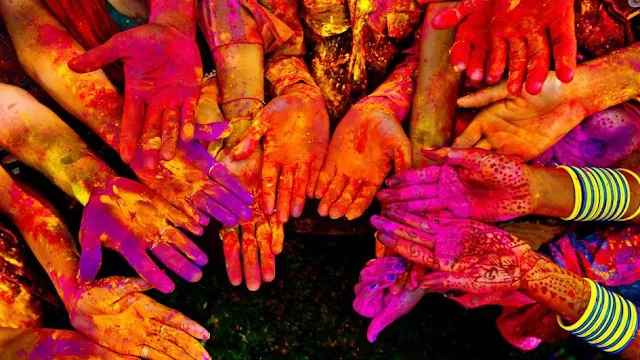
Holi, also called the Festival of Colours, is a popular Hindu spring festival observed in India, Nepal, Srilanka, and countries with large Hindu diaspora populations, such as Suriname, Guyana, South Africa, Trinidad, UK, USA, Mauritius, and Fiji.
In West Bengal of India and Bangladesh it is known as Dolyatra (Doul Jatra) or Basanta-Utsav ("spring festival").
The most celebrated Holi is that of the Braj region, in locations connected to the god Krishna: Mathura, Vrindavan, Nandagaon, and Barsana. These places have become tourist destinations during the festive season of Holi, which lasts here to up to sixteen days.
In West Bengal of India and Bangladesh it is known as Dolyatra (Doul Jatra) or Basanta-Utsav ("spring festival").
The most celebrated Holi is that of the Braj region, in locations connected to the god Krishna: Mathura, Vrindavan, Nandagaon, and Barsana. These places have become tourist destinations during the festive season of Holi, which lasts here to up to sixteen days.
The main day, Holi, also known as Dhulheti, Dhulandi or Dhulendi, is celebrated by people throwing colored powder and colored water at each other. Bonfires are lit the day before, also known as Holika Dahan (burning of Holika) or Chhoti Holi (little Holi). The bonfires are lit in memory of the miraculous escape that young Prahlad accomplished when Demoness Holika, sister of Hiranyakashipu, carried him into the fire. Holika was burnt but Prahlad, a staunch devotee of god Vishnu, escaped without any injuries due to his unshakable devotion. Holika Dahan is referred to as Kama Dahanam in Andhra Pradesh.
Holi is celebrated at the end of the winter season on the last full moon day of the lunar month Phalguna (February/March), (Phalgun Purnima), which usually falls in the later part of February or March. In 2019, Holika Dahan is on March 20, 2019 and Holi (Dhulandi) is on March 21, 2019.
Rangapanchami occurs a few days later on a Panchami (fifth day of the full moon), marking the end of festivities involving colors.
There are many stories of the origin of Holi. The most widely held belief is that Holi marks the day when the devotee of lord Vishnu, Bakt Prahlad, seated on the lap of demoness Holika, was saved from the effect of the fire by God and the demoness got burnt instead. Other stories relate to the death of demon Putana at the hands of lord Krishna and to the burning of demoness Hoda by children. Some link the festival with the worship of Karma, God of pleasure and destiny. The main day, Holi, also known as Dhulheti, Dhulandi or Dhulendi, is celebrated by people throwing colored powder and colored water at each other. Bonfires are lit the day before, also known as Holika Dahan (death of Holika) or Chhoti Holi (little Holi). The bonfires are lit in memory of the miraculous escape that young Prahlad had when Demoness Holika, sister of Hiranyakashipu, carried him into the fire. Holika was burnt but Prahlad, a staunch devotee of Lord Vishnu, escaped without any injuries due to his unshakable devotion. Holika Dahan is referred to as Kama Dahanam in Andhra Pradesh. Holi festival has an ancient origin and celebrates the triumph of 'good' over 'bad'. The colorful festival bridges the social gap and renews sweet relationships. It is the second most important festival of India after Diwali. Holi in India is a festival of fun and frolic and has been associated with the immortal love of Krishna and Radha. The exuberance and the festivity of the season are remarkable. On this day, people hug and wish each other 'Happy Holi'. People rub 'gulal' and 'abeer' on each others' faces and cheer up saying, "bura na maano Holi hai". Holi also gives a wonderful chance to send blessings and love to dear ones wrapped in a special Holi gift. Unlike all the other festivals of India, Hindu Holi festival is one such festival where one can put down the social taboos and indulge in the intoxicating drinks and sweets prepared by using opium. It is a festival of romance often represented by the love-play of Radha and Krishna. Brij Holi is famous all over the world for its gaiety in spirit. Each year, young and old, men and women, all indulge themselves in the spirit of colors and for once forget the social taboos. There are mouthwatering delicacies to savor such as 'Gujhias' and 'Papris' and there are interesting traditions and customs of Holi that have their own regional variances. We will also talk about making natural and healthy colors and safety precautions that one must take to enjoy Holi.










+01.jpg)























0 Comments